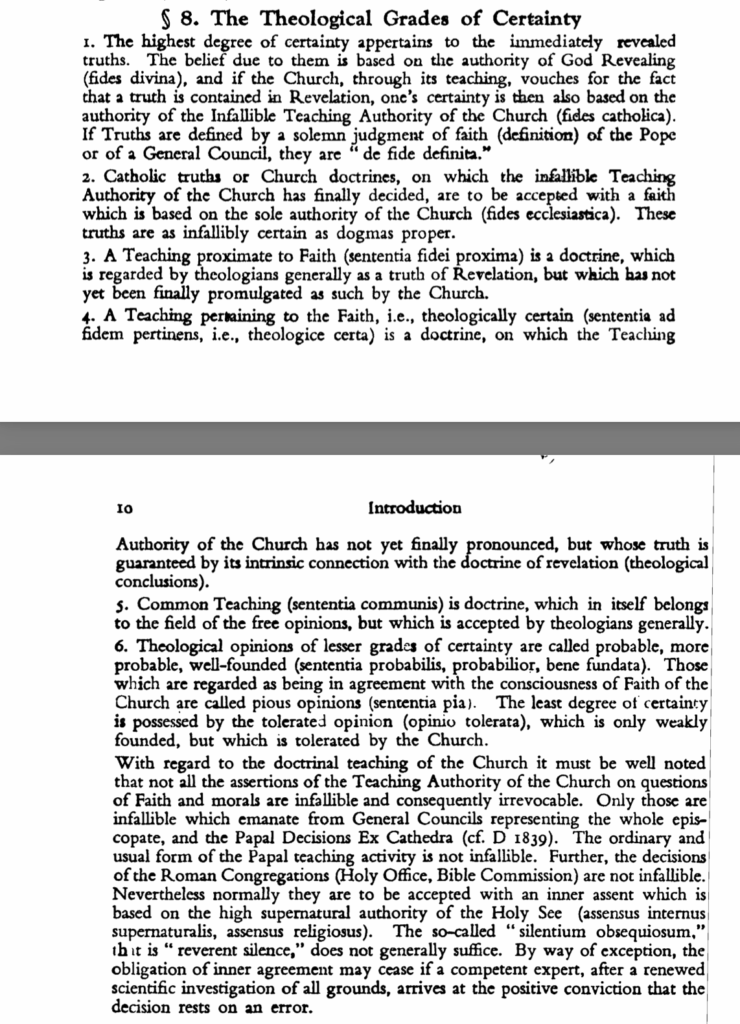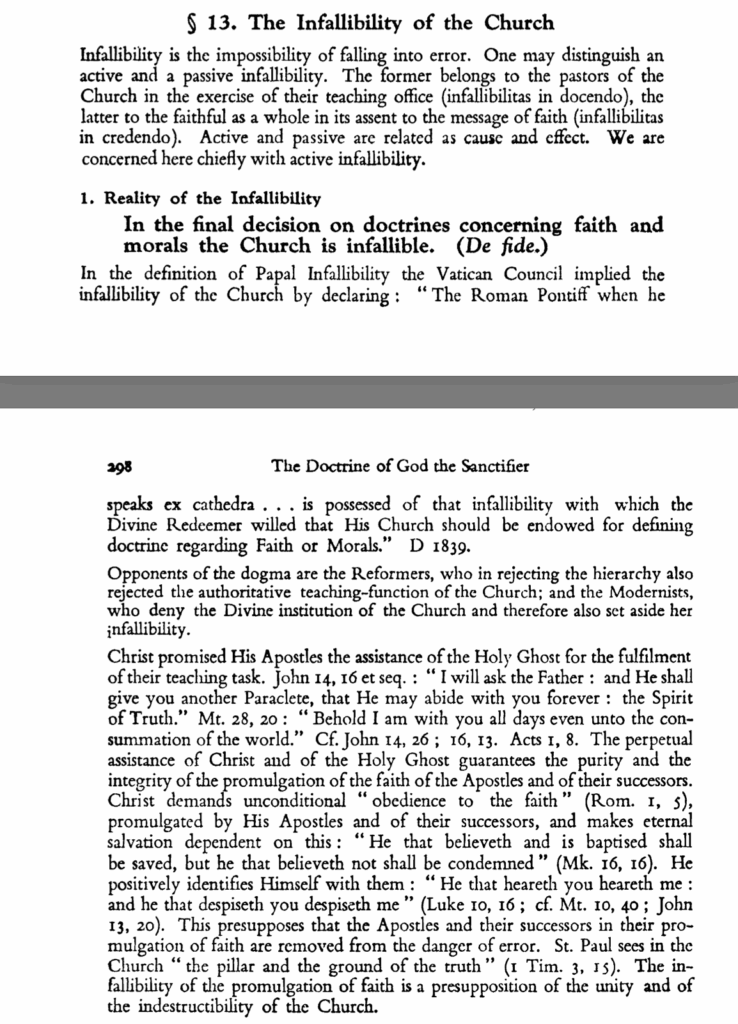When the Son of Man comes, will He find faith on earth?—Christ in Saint Luke 18:8.
From 2013 to 2020, a website called The Wild Voice conglomerated all of Francis’ heresies, errors and leftist statements. After listing hundreds of these, the site-manager apparently couldn’t keep up and stopped compiling it in 2020. Now, Leo continues the exact same theology, but presented in a less bombastic manner.
But what if Leo goes further and “ordains a woman” or “changes the words of consecration”? Of course, leftists will celebrate. Mainstream US bishops, however, will ignore it. They will simply hope the fall-out from this next iteration of apostasy fall on the heads of successors—not themselves.
Yet the traditional response will be more complex. There will be three categories of traditionalists in reaction:
1. Those who opposed his validity from the start (and those who join them.)
2. Those who insist “we have had heretical Popes in the past,” and therefore we should simply ignore that “ordination of women” (or whatever super-heresy comes down the pike) and just stay Catholic anyway.
3. Those who go Eastern Orthodox.
Let’s proceed by process of elimination.
Number three: While many of us traditional Catholics (including me) admit it’s better to have a Magisterium stuck in the 6th century (like the Eastern Orthodox) than stuck in the 1970s (like most liberal prelates in the Vatican and US chanceries today) I don’t think many Catholics will go Eastern Orthodox. This is true, even though they have valid sacraments.
Number two: This is the “Recognize and Resist” crowd. They will say things like “I don’t have to obey the ‘ordination of women,’ as it’s not ex-cathedra.” But contrary to what many confused American Catholics believe about ex-cathedra statements, most of the old-school Popes and Fathers taught that papal infallibility extends far beyond the only two ex-cathedra statements from 1854 and 1950.
Number one: Here is where we look to the sedevacantists (aka sedevax, as my friend Pat calls them.) There are 58-sedevax who believe Pope Pius XII was the last valid Pope. There are also 23-sedevax who believe Pope Benedict XVI did not resign properly. For the latter crowd, Benedict remained the Supreme Pontiff until his death on 31 Dec 2022. (This would mean the last two prelates on the throne are invalid from either 13 Mar 2013—or more likely New Year’s Day 2023—up until today.) But the 23-sedevax are more accurately labeled interregnumists as true sedevancantism is limited to the 1958-style.
In any case, here’s the rub: If Francis and Leo are valid Popes, and if infallibility extends to more than the two ex-cathedra statements (as most Popes, doctors and early Fathers insist) then Amoris Laetitia and Fidelis Supplicans (and any future “ordination of women”) requires consent of the will, or at least no public opposition from Trad. Inc. They can’t keep whittling down papal infallibility to what Eastern Orthodox believe about the Pope in Rome (namely, that he’s a useless-figurehead) and still call themselves Roman Catholics.
But most traditionalists today are terrified of being labeled sedevacantist. So let’s sideline that debate and consider the more central issue behind it. Truly, I believe the question prior to Who is valid on the Chair of Peter is instead: What is the more important mark of the Church: Infallibility or Visibility? Really, I mean this. So try to forget your fervent-love or fervent-hatred for sedevacantism for the rest of this article and simply try to read this soberly and clearly. We need to go upstream of validity, at least for today.
Let’s consider the levels of theological certainty as outlined by the pre-Vatican II dogmatic expert Ludwig Ott in his gold-standard book titled Fundamentals of the Catholic Faith:

Dr. Ludwig Ott lists above the levels of theological certainty as six levels from highest to lowest on the infallibility scale. I will summarize the above screenshot here:
- De Fide truths are absolutely infallible statements coming from both the Bible and/or Tradition. These are immediately revealed truths of Christ to the Apostles flowing into the Magisterial authority of the Catholic Church. The list of infallible truths is obviously a lot larger than the two ex-cathedra statements coming from Popes in 1854 and 1950. Here’s a list of 238 infallible dogmas of the Church. (Although a liberal, I personally don’t believe Pope Benedict XVI ever violated any of those 238 as Pope, although I am open to correction.)
- Fides Ecclesiastica or “Faith of the Church” are articles also considered infallible because they are based on the authority of the Church, even if not found explicit in the Sacred Scriptures. These are in the hundreds.
- Proximate Teachings are doctrines generally considered revealed truths of Revelation, yet never having been formally promulgated. These are true by corollary to De Fide statements. These are also in the hundreds.
- Theologically Certain teachings are doctrines not yet pronounced by the authority of the Church, but still considered true by most solid theologians.
- Sententia Communis (or Common teaching) are also truths of the Catholic faith, but pertaining more to theological discussions than what is required for salvation.
- Theological opinions are orthodox opinions that are probably true, yet still open for debate.

In Ott above, notice that the notion of the Visibility of the Catholic Church only reaches to the fourth level of theological certainty, namely, “theologically certain.” That is, the Church should always be visible, but the formal visibility is questioned

If you read the above screenshots of Ott, infallibility means it’s impossible for the Catholic Church to fall into error. But visibility means we maintain a “visible foundation” and a “visible and external priesthood.” Could it be possible that the hierarchy lose the ancient faith while only a small remnant of clergy and lay people keep it?
Most traditionalists will say “no” because of the importance of visibility.
But as we saw above, infallibility holds a much higher place in Catholic theological certainty than visibility. There were times prophesied by saints that the Catholic Church would lose visibility, but never without infallibility (someone on the planet keeping the ancient faith in his or her heart.)
Of course, this might sound Protestant to some of you. The Protestant rebels claimed the true Christians were “an invisible community of believers.” The Council of Trent and Vatican I stated against this that there must be a “visible foundation” and a “visible and external priesthood” in the true Church. But the same Fathers of Vatican I made it even more clear that a heretic could never hold the office of Supreme Pontiff.
Even if you are a traditional Catholic who is terrified of the label “sedevacantist,” you still must agree that the Catholic Church’s Magisterium holds that infallibility is more important than visibility. Why? Again, because “infallibility of the Catholic Church” is De Fide (the highest level of theological certainty) whereas “visibility of the Catholic Church” is at that lower level of sententia ad theologice certe.
That is, it is certain but not infallible that the Catholic hierarchy must be visible. But it’s an infallible teaching of the Catholic Church that her own valid hierarchy cannot be heretical. Key word there is valid. This means that according to Ott, the Catholic Church losing visibility is improbable. But losing infallibility is impossible. This is true, even if the ancient infallible faith remain only in the minds of a few clergy not wearing miters. In fact, most the doctors of the Church agree that a heretic cannot hold a valid office in the Catholic Church. And this applies just as much to the episcopacy as the papacy.
Try this experiment with me: Can you name one bishop in the United States that holds to Extra Ecclesiam Nulla Salus? I have spoken to America’s most conservative bishops and none of them hold to “No Salvation outside the Catholic Church.” Yet that’s a dogma of the faith. Therefore, every bishop I have ever met (besides a few like Viganó who are not ordinaries) are material heretics. (Of course, I cannot call them formal heretics as I have no plans on starting a canonical trial against anyone.)
But as I wrote before, the saints teach that even a layman can recognize heresy in a cleric without need of a formal canonical trial.
Did you know that many doctors of the Church say the Catholic Church will lose visibility for a time at the end of the world? Cardinal Manning summarizes many doctors of the Church:
“The apostasy of the city of Rome from the vicar of Christ and its destruction by Antichrist may be thoughts so new to many Catholics, that I think it well to recite the text of theologians of greatest repute. First Malvenda, who writes expressly on the subject, states as the opinion of Ribera, Gaspar Melus, Biegas, Suarrez, Bellarmine and Bosius that Rome shall apostatise from the faith, drive away the Vicar of Christ and return to its ancient paganism… Then the Church shall be scattered, driven into the wilderness, and shall be for a time, as it was in the beginning, invisible, hidden in catacombs, in dens, in mountains, in lurking places; for a time it shall be swept, as it were from the face of the earth. Such is the universal testimony of the Fathers of the early Church.”—Cardinal Manning, The Present Crisis of the Holy See, 1861.
Similarly, Archbishop Viganó recently wrote now in 2025: “At the time of the Savior’s first coming, the kingdom of Israel and the temple had neither a legitimate King nor legitimate High Priests: civil and religious authority was held by figures appointed by the emperor. In the Second Coming at the end of the world, this vacancy of authority will be even more evident, because Our Lord will restore all things in Himself—Instaurare omnia in Christo (Eph 1:10)—at a historical moment when Evil will dominate in all areas of daily life, in all institutions, in all societies. And His Triumph will be a triumphant, crushing, total, inexorable victory over all the lies and crimes of the Antichrist and the Synagogue of Satan.”
I add the simple fact that Catholic dogma and Church history both reveal it would be improbable to have two antipopes in a row, but absolutely impossible to have two non-Catholic popes in a row. But as I stated above, this is bigger than the papacy question. Think hard now on which Roman Catholic bishop and chancery has kept the same faith and liturgy as the Church Fathers the world over. You will come up with none. Zero. Goose egg.
A friend recently pointed out to me that when Christ asks When the Son of Man comes, will He find faith on earth? this shocking line specifically refers to the Church losing the faith, not the world. Why? Because for all of Catholic Church history, Christ is supposed to find faith in the Church, not in the world!
The four marks of the Church are: One, Holy, Catholic and Apostolic. Notice that visibility is not on the list. In Fundamentals of Catholic Dogma, Ludwig Ott lists hundreds of infallible statements from the Catholic Church (much more than the two ex-cathedra statements.) In his book, we see that the ancient faith is infallible, but visibility is not infallible. This is the dogmatic reason we can believe the prophesies of Padre Pio and Archbishop Fulton Sheen who both predicted that “Satan is soon to rule a counterfeit-church.”
